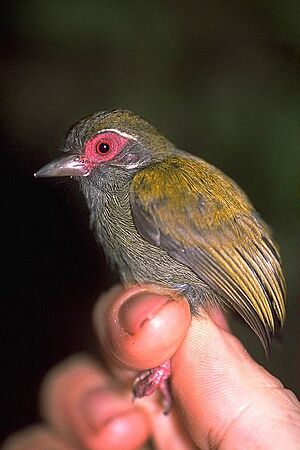African piculet facts for kids
Quick facts for kids African piculet |
|
|---|---|
 |
|
| Conservation status | |
| Scientific classification | |
| Genus: |
Verreauxia
|
| Species: |
africana
|
| Synonyms | |
|
|
The African piculet (Verreauxia africana) is a tiny bird found in the forests of central and western Africa. It's part of the Picidae family, which includes woodpeckers. This little bird is special because it's the only species in its group, called Verreauxia.
You can find the African piculet in many countries, including Angola, Cameroon, Ghana, and Uganda. It lives in a very large area and is quite common in those places. Because of this, experts from the International Union for Conservation of Nature say it's not in danger of disappearing. They have given it a conservation status of "least concern".
What Does the African Piculet Look Like?
The African piculet is a small bird, only about 9 to 10 centimeters long. That's about the length of your finger!
- The male bird has a reddish or chestnut-colored forehead.
- Its head is usually greyish-green or olive-green.
- Female birds have a forehead that is the same color as the rest of their head.
- The top part of their body is a dark green with a hint of yellow.
- Their wings and tail are brownish-black.
- The throat and chest are dark grey, and the belly is a lighter grey.
- They have a black beak, red eyes, and reddish legs.
- Young piculets look similar to the adults but have some grey or light brown colors mixed into their feathers.
Where Does it Live and What Does it Do?
The African piculet mostly lives in lowland forests that are growing back after being cut down. It's a very active bird!
- You can often see them flying around in pairs or small groups of three.
- Sometimes, they even join up with other types of birds to look for food.
- They search for food in the lower parts of trees, in bushes, and in thick plants.
- Even though they are small, they are related to woodpeckers. They use their beaks to tap and split open branches. This helps them find insect larvae, like grubs, hidden inside.
- They also pick other insects off plants.
- Interestingly, they don't seem to be interested in ants.
African piculets have been seen nesting and raising their young between June and February in different parts of Africa. They build their nests within 5 meters of the ground. Usually, they lay two eggs. Both the mother and father bird help to take care of the young.
Its Family Tree
The African piculet was first officially described in 1855. Two French scientists, Jules Verreaux and Édouard Verreaux, found a specimen of the bird in Gabon, West Africa.
- They first placed it in a group called Sasia.
- However, in 1856, a German bird expert named Gustav Hartlaub created a new group just for this bird, called Verreauxia.
- Today, the African piculet is the only species in the Verreauxia group. This means there are no different types or subspecies of it.


